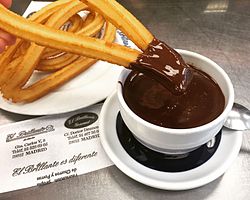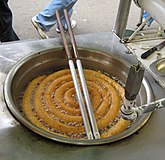 A plate of churros with a cup of chocolate A plate of churros with a cup of chocolate | |
| Alternative names | Tejeringos |
|---|---|
| Type | Fried dough |
| Course | Breakfast, lunch, dinner, snack |
| Place of origin | Iberian Peninsula |
| Region or state | Southern Europe |
| Serving temperature | Hot |
| Main ingredients | Deep-fried choux pastry (flour, water, butter, eggs, salt) |
A churro (Spanish pronunciation: [ˈtʃuro], Portuguese pronunciation: [ˈʃuʁu]) is a type of fried dough from Spanish and Portuguese cuisine, made with choux pastry dough piped into hot oil with a piping bag and large closed star tip or similar shape. They are also found in Latin American cuisine, Philippine cuisine and in other areas that have received immigration from Spanish and Portuguese-speaking countries, especially in France and the Southwestern United States.
In Spain, churros can either be thin (and sometimes knotted) or long and thick, where they are known as porras, jeringos, or tejeringos in some regions. They are normally eaten for breakfast dipped in coffee, or in hot chocolate for an afternoon snack. There are also two slightly different snacks in Portugal, called porra and fartura, which are filled with jelly instead of the doce de leite traditional to Brazilian churros.
History
The origin of churros is unclear. But according to food historian Michael Krondl, "today's churro is not that different from a recipe for a flour and water fritter that you find in Apicius, a Roman cookbook dating from the 1st century AD. And there are recipes from the Ancient Greeks, but it's probably even older than that. In the Mediterranean basin it's basically been around forever".
But there are also other theories: one of them is that the churro was made by Spanish shepherds to substitute for fresh baked goods. Churro paste was easy to make and fry in an open fire in the mountains, where shepherds spend most of their time, but the nomadic lifestyle of the shepherds and the large quantities of oil or fat needed to fry churros make that unlikely.
Another theory, discredited as a hoax suggests the concept was brought to Europe from China by the Portuguese. The Portuguese sailed for the Orient; as they returned from Ming-dynasty China to Portugal, they brought along with them new culinary techniques. One included altering dough for youtiao, also known as yóuzháguǐ in southern China, which bears a resemblance to the churro. The new pastry was soon introduced to Spain, where it was modified to have the dough extruded through a star-shaped nozzle (compare a piping bag) rather than pulled.
Etymology
According to the Diccionario de la lengua española, churro is onomatopoeic, ultimately imitative of the sound of frying.
Preparation
| This section needs additional citations for verification. Please help improve this article by adding citations to reliable sources in this section. Unsourced material may be challenged and removed. (July 2024) (Learn how and when to remove this message) |

Churros are fried until they become crunchy, and may be sprinkled with sugar. The surface of a churro is ridged due to having been piped from a churrera, a syringe-like tool with a star-shaped nozzle. Churros are generally prisms in shape, and may be straight, curled or spirally twisted.
Like pretzels, churros are sold by street vendors, who may fry them freshly on the street stand and sell them hot. In Spain and much of Latin America, churros are available in cafes for breakfast, although they may be eaten throughout the day as a snack. Specialized churrerías, in the form of a shop or a trailer, can be found during the holiday period. In addition, countries like Colombia, Peru, Spain and Venezuela have churrerías throughout their streets. In Portugal, they are commonly eaten at carnivals, fairs and other celebrations, where they are made freshly at street stands.
The dough is a mixture of flour, water and salt. Some versions are made of potato dough. Depending on the recipe, it may not be vegan, as they can contain butter, milk or eggs.
Variations
-
Churros drizzled with chocolate
-
 "Tejeringos" or "Calentitos", an Andalusian variation of the churro
"Tejeringos" or "Calentitos", an Andalusian variation of the churro
-
 Churros in Guatemala
Churros in Guatemala
-
 Churros in the Philippines
Churros in the Philippines
In Seville (Andalusia), the name "calientes" (meaning hot) or "calentitos de rueda" is sometimes used instead of the word churro. These tend to refer to the thicker variant, called porra. Calientes are usually fried in the shape of a continuous spiral and cut into portions afterwards. The center of the spiral is thicker and softer, and for many a delicacy in itself. The standard "churro" is also sold under the name "calentitos de papas", the name referring to the softer mashed potato-like texture.
In parts of eastern Andalusia, a much thinner dough is used, which does not allow for the typical ridges to be formed on the surface of the churro. The final result therefore has a smooth surface, and is more pliable and of a slightly thinner diameter than standard Spanish churros. Another difference is that sugar is never sprinkled on them, because the flavour is not considered suitable.
Filled, straight churros are found in Cuba (with fruit, such as guava), Brazil (with chocolate, doce de leite, among others), and in Argentina, Bolivia, Peru, Chile and Mexico (usually filled with dulce de leche or cajeta but also with chocolate and vanilla).
In Colombia and Venezuela, churros are round like doughnuts sprinkled with sugar and filled with bocadillo (membrillo or guava paste), arequipe and sweetened condensed milk. In Spain, a considerably wider diameter is used to accommodate the filling. In Uruguay, churros can also come in a savoury version, filled with melted cheese.
In the Philippines, churros are typically straight, or bent into U-shapes or circular shapes dusted with white sugar and are popular during Christmas.
In Thailand, churros are commonly known as Patonggo Spain (Thai: ปาท่องโก๋สเปน, "Spanish deep-fried dough stick"), according to the type of fried dough that Thais are familiar with, namely Youtiao or Patonggo in vernacular.
Churros in American theme parks and street fairs are most often rolled in cinnamon sugar or other flavored sugars.
Similar dishes
In the Middle East, a churro-like fried dough-based sweet is known as Karabeej Halab.
Youtiao, a traditional Chinese fried dough with a long history. It is well known in Thailand as Patonggo.
See also
References
- Miguel, Amando de (28 January 2008). "Variaciones regionales del habla popular". Libertad Digital (in Spanish). Retrieved 8 October 2024.
- ^ Zaera, Beatriz (3 December 2024). "Los churros vienen de China" y otros grandes bulos gastronómicos que corren por las redes". El País (in Spanish). Retrieved 3 December 2024.
- "Cinco placas portuguesas que são muito estranhas para brasileiros". Folha de S.Paulo (in Portuguese). 17 November 2015. Retrieved 17 July 2020.
- Randolph, Mike (17 June 2020). "The complex origin of beloved churros". BBC.
- "Churro Encyclopedia". Archived from the original on 2011-09-29. Retrieved 2011-12-27.
- "Churros: The Hidden History". The Huffington Post. 2011-08-18. Retrieved 2011-10-16.
- "The Hidden History of Churros". Fox News. 9 December 2016.
- "Churros: a secret history". Archived from the original on 23 February 2012.
- "churro". Diccionario de la lengua española.
- Díaz, Ana (2012-10-31). "Calentitos versus churros". ABC. Archived from the original on 2019-12-31. Retrieved 19 June 2014.
- "Una de calentitos". Toda una amalgama. 18 October 2013.
- "La muralla duda: rueda o papa". Diario de Sevilla. 18 May 2009. Archived from the original on 27 August 2014. Retrieved 19 June 2014.
- Veneracion, Connie. "The Spanish Influence on Filipino Cuisine". The Spruce Eats. Retrieved 14 December 2018.
- Aranas, Jennifer (2012). The Filipino-American Kitchen: Traditional Recipes, Contemporary Flavors. Tuttle Publishing. ISBN 9781462904914.
- "How to Cook Churros con Tsokolate with Cocoa Tablea Drink". Asian in America. 5 January 2013. Retrieved 14 December 2018.
- ^ "ชูโรส ปาท่องโก๋สเปน แป้งกรอบนานเนื้อนุ่มในทำเองได้". Kapook.com (in Thai). 2024-08-31. Retrieved 2018-05-22.
- Maha Salah (2 January 2021). "Karabeej Halab". Middle East Monitor. Retrieved 2 May 2022.
- Chongchitnant, Pailin (24 July 2020). "Crisp and Airy Chinese Doughnuts (Pa Tong Ko)". Hot Thai Kitchen. Retrieved 2020-07-24.
External links
- [REDACTED] Media related to Churros at Wikimedia Commons
| Doughnuts, fritters and other fried-dough foods | |||||
|---|---|---|---|---|---|
| Sweet | |||||
| Savory |
| ||||
| Companies | |||||
| Lists | |||||
| See also |
| ||||
| Cultural domain of the Community of Madrid | ||
|---|---|---|
| History |
|  |
| Language | ||
| Sports |
| |
| Cuisine | ||
| Traditional music | ||
| Festivals | ||
| Category | ||
| Mexican breads | |
|---|---|
| Pan salado | |
| Pan dulce | |
| |
| Jewish cuisine | |||||||||||
|---|---|---|---|---|---|---|---|---|---|---|---|
| History | |||||||||||
| Types | |||||||||||
| Religious dietary laws and related terms | |||||||||||
| Chefs | |||||||||||
| Religious foods | |||||||||||
| Breads |
| ||||||||||
| Sweets |
| ||||||||||
| Pastries | |||||||||||
| Fried foods |
| ||||||||||
| Dumplings, pastas and grain dishes |
| ||||||||||
| Casseroles and savory baked dishes | |||||||||||
| Snacks and other baked goods | |||||||||||
| Sandwiches | |||||||||||
| Egg dishes | |||||||||||
| Meat dishes | |||||||||||
| Fish dishes | |||||||||||
| Salads and pickles | |||||||||||
| Vegetable dishes | |||||||||||
| Soups and stews | |||||||||||
| Cheeses and other dairy products | |||||||||||
| Condiments, dips and sauces | |||||||||||
| Beverages | |||||||||||
| Herbs, spices and seasonings | |||||||||||
| Eateries | |||||||||||
| Related lists | |||||||||||
- Argentine cuisine
- Bolivian cuisine
- Brazilian cuisine
- Chilean desserts
- Colombian cuisine
- Cuisine of the Southwestern United States
- Ecuadorian cuisine
- French desserts
- Mexican breads
- Mexican desserts
- New Mexican cuisine
- Paraguayan cuisine
- Peruvian cuisine
- Philippine desserts
- Portuguese cuisine
- Spanish desserts
- Uruguayan desserts
- Venezuelan cuisine
- Sephardi Jewish cuisine
- Philippine breads
- Fried dough
- Choux pastry
- Cuban cuisine
